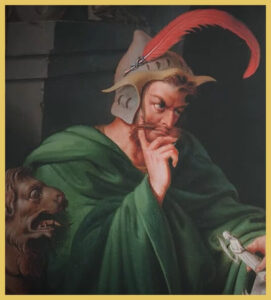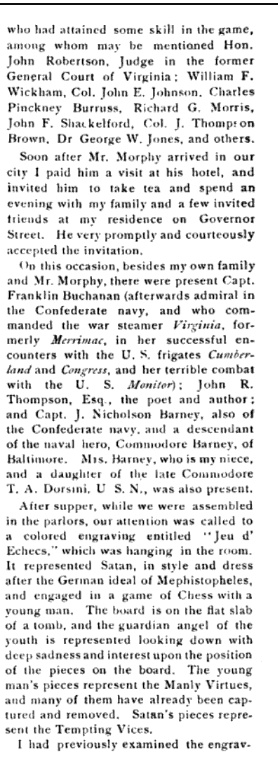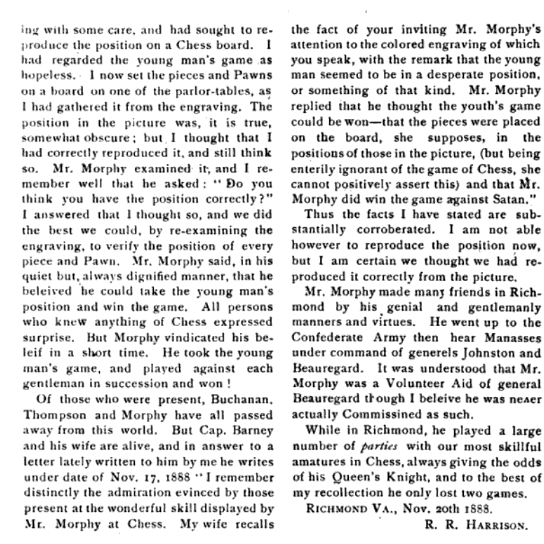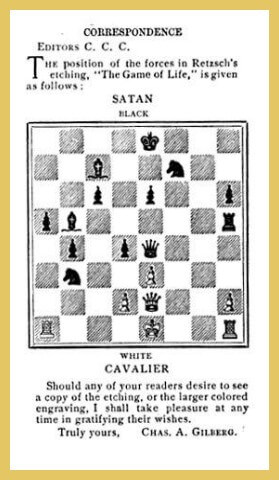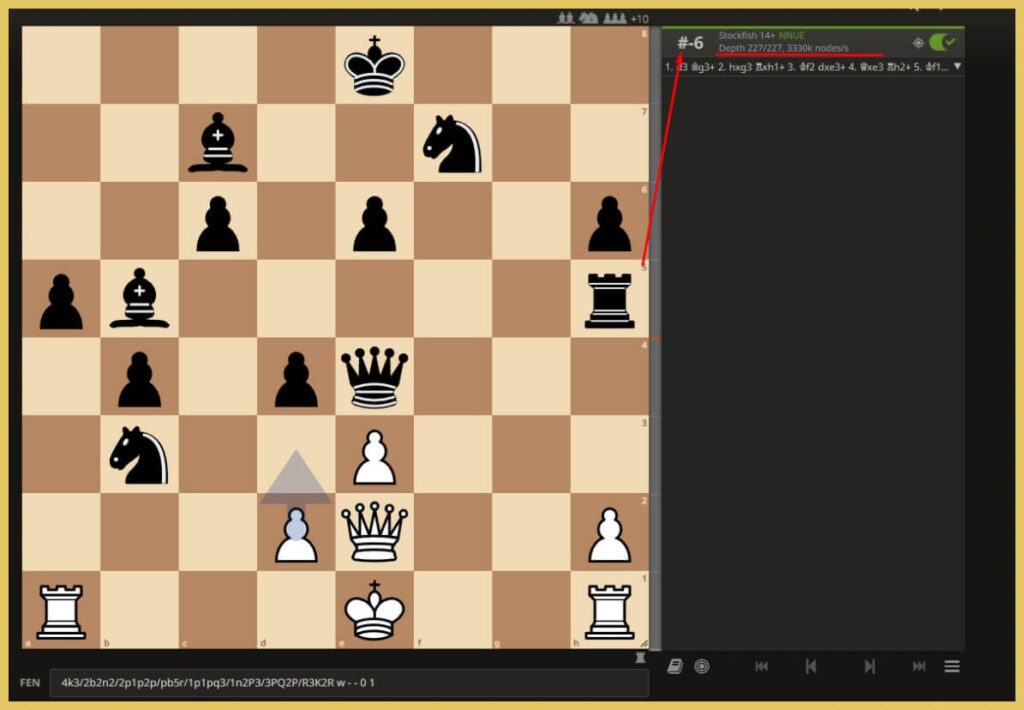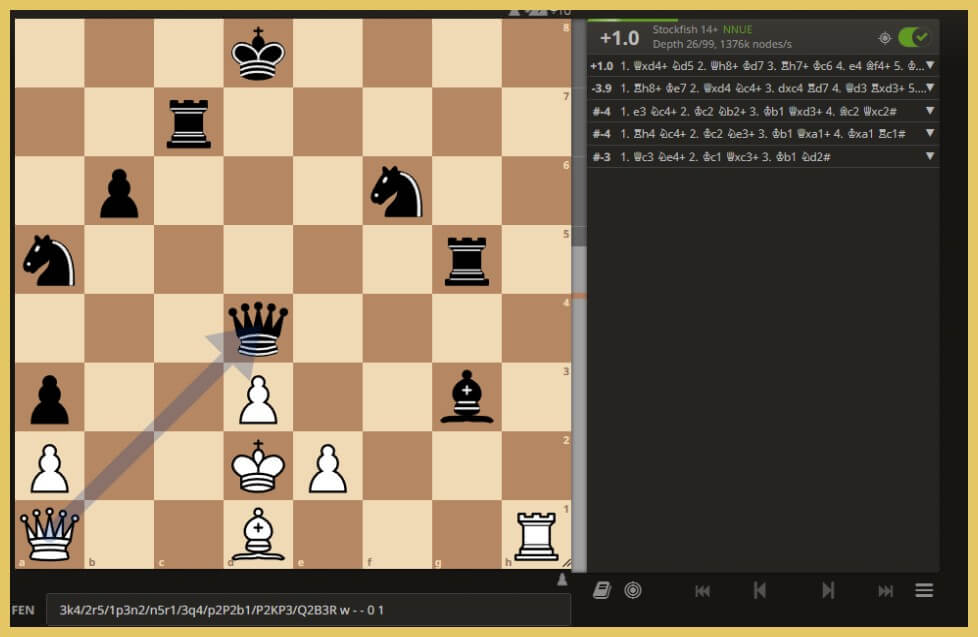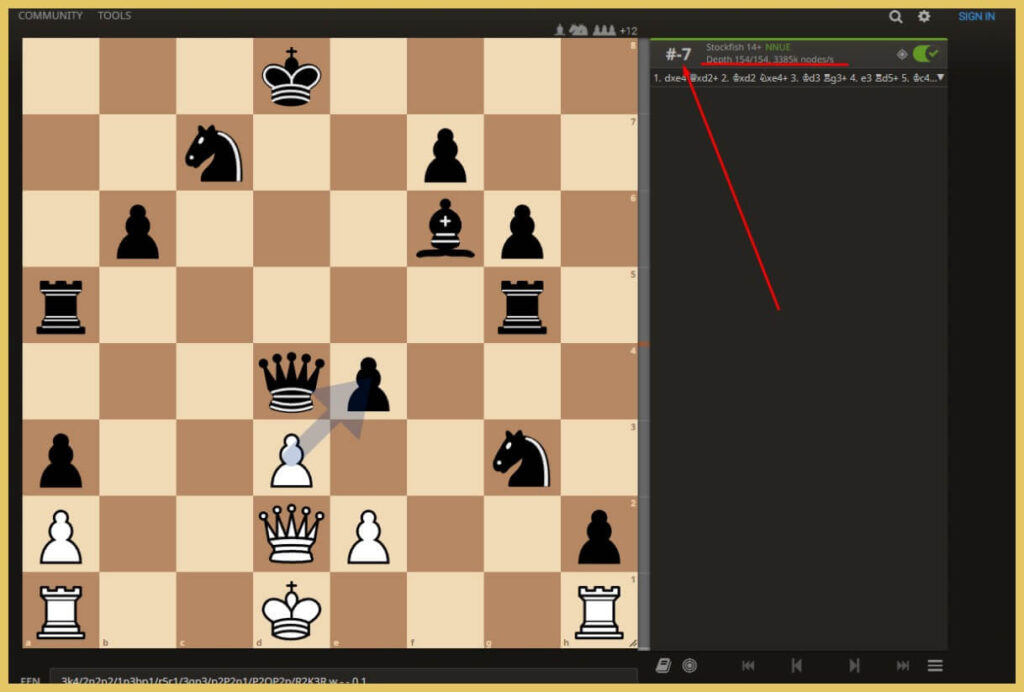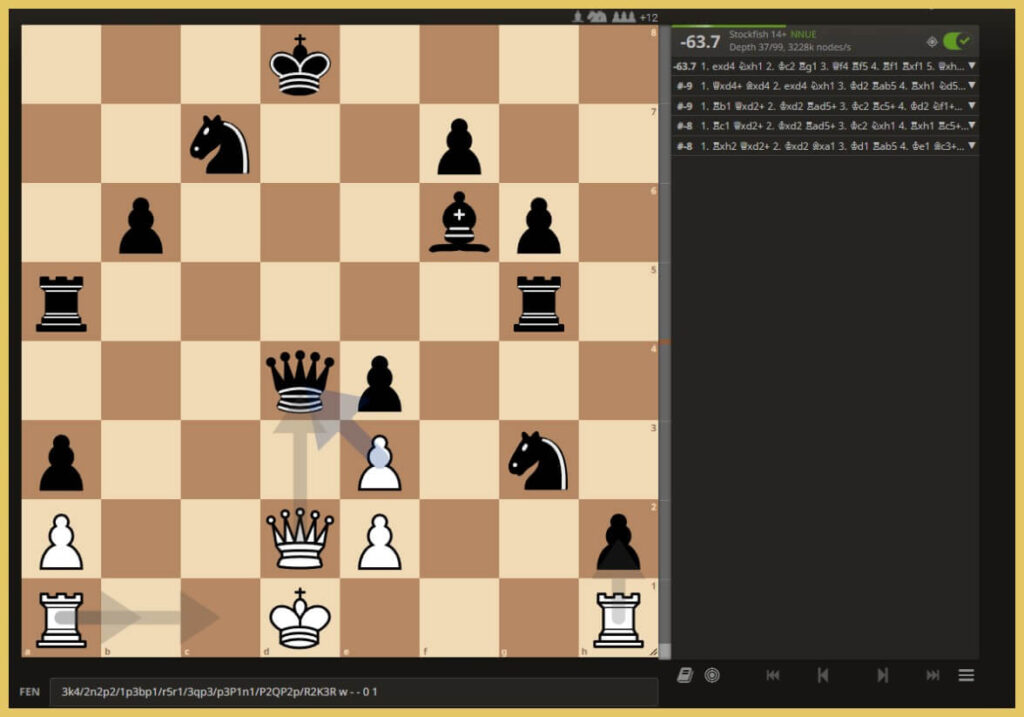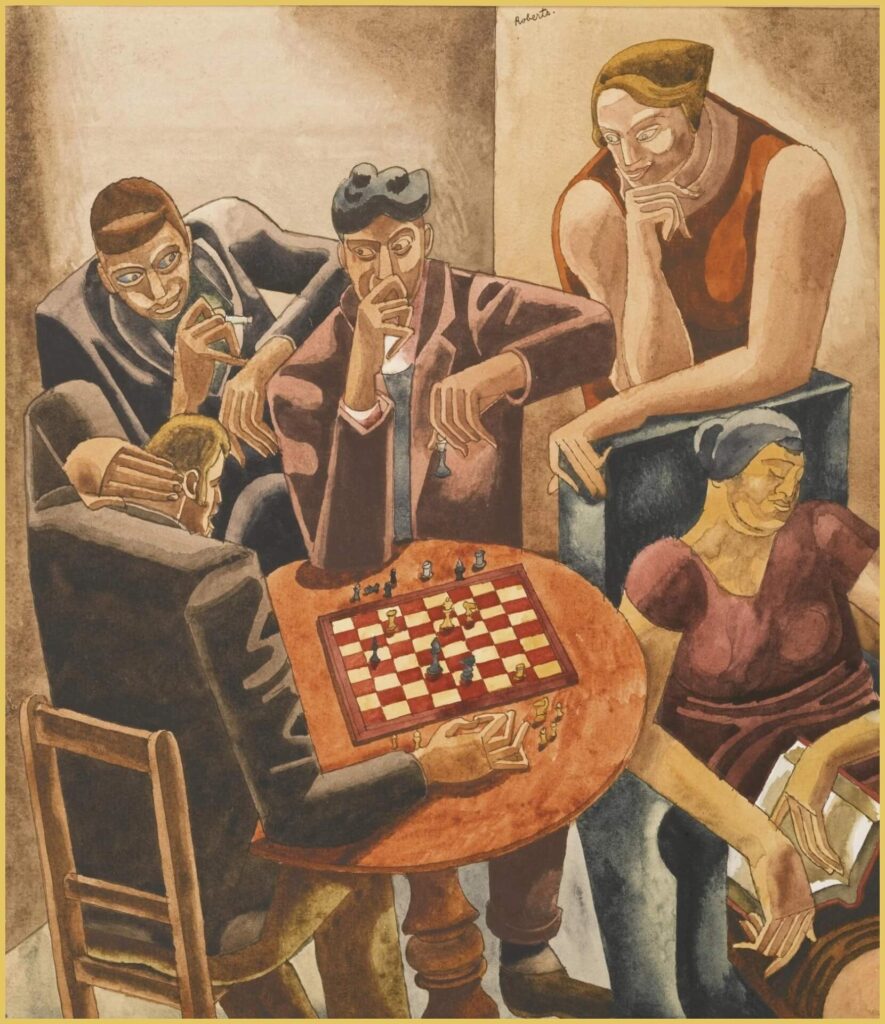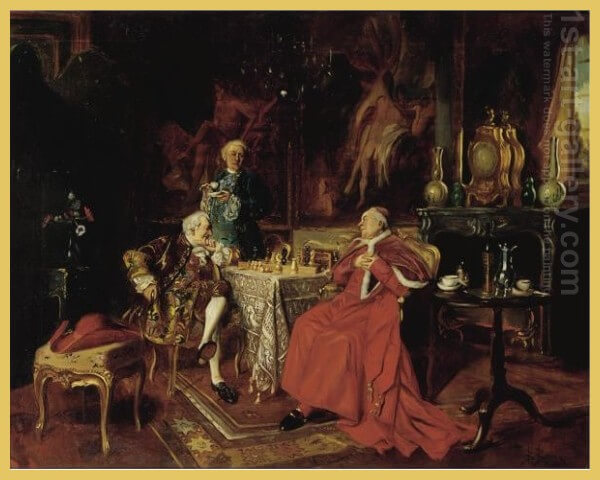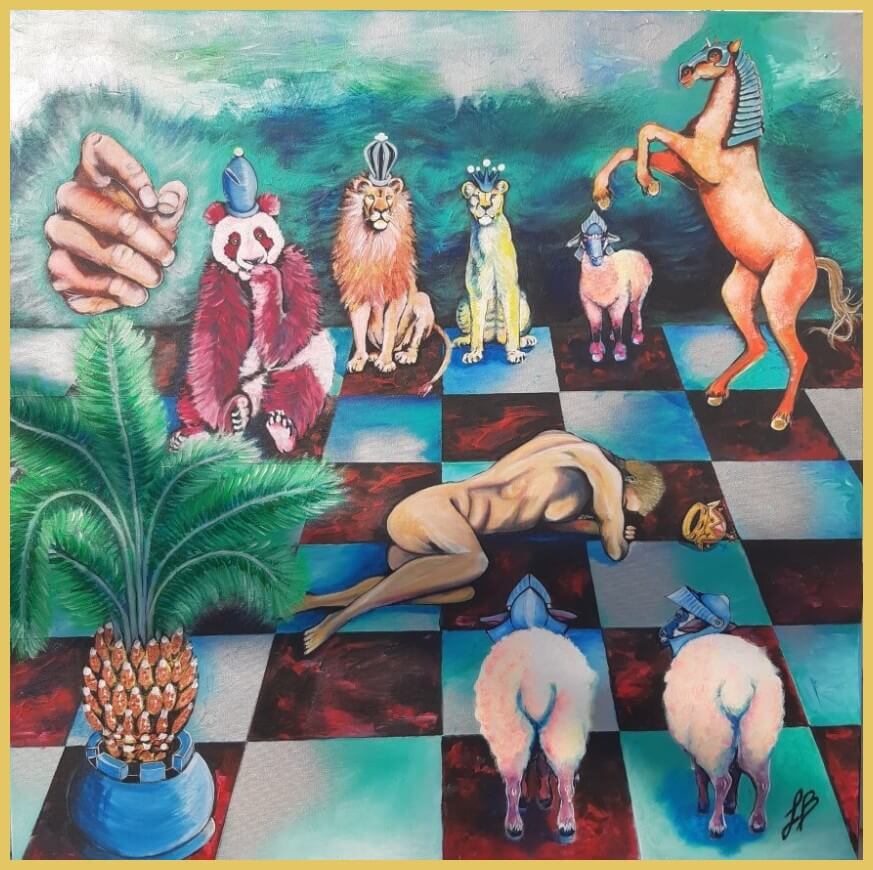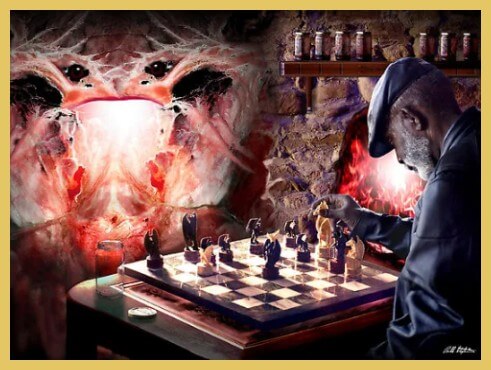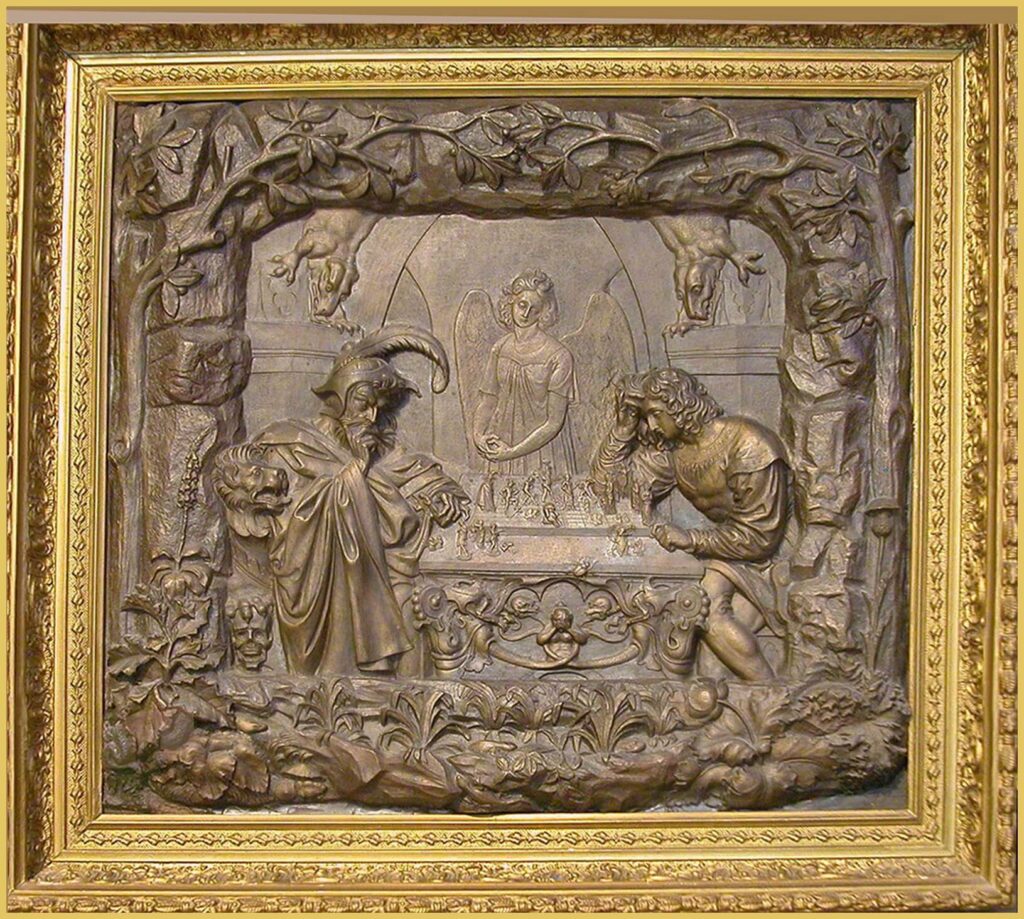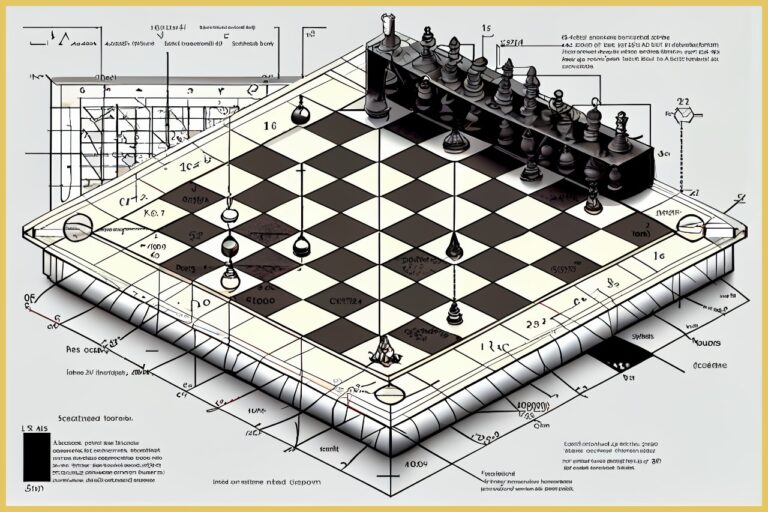Checkmate Painting
Are you ready to take your chess obsession to the next level?
Table of Contents
Have you ever heard the phrase ‘there is always one more move’?
Well, let me tell you, that phrase is the essence of chess, and it takes on a whole new meaning when you lay your eyes upon the Checkmate Painting.
What is the story of one more move painting?
Legend has it that a chess genius once stumbled upon this painting and, after staring at it for hours, discovered secret moves that had never before been seen.
Now, to find out whether or not the story of one more move painting is true, you will have to read the rest of the article. ( or check the FAQ xD ) But one thing is certain – this painting has captured the imaginations of 1000s chess players and art enthusiasts alike.
On top of all that, there are a ton of questions being asked about this piece, and who wants to spend hours scouring the internet for answers when you can have it all laid out for you in one humongous piece?
With that… let’s start with some basic data
Painting of Checkmate – Data

| Original checkmate painting Value | 67.500 GBP |
| Original checkmate painting Dimensions | 12 x 15.3/8in. (32.3 x 39cm.) |
| Original checkamte painting Type | oil on panel |
| Original checkmate painting Price | 67.500 GBP sold on 7.10.1999 at Christie’s Auction |
| Original checkmate painting Name | Die Schachspieler |
| Original checkmate painting Author | Friedrich Moritz August Retzsch (1779-1857) |
A painting called checkmate – why is the painting called checkmate? What other names did it have?
- Original name: schachspielers
- Satan Playing At Chess With Man, For His Soul. – The Saturday Magazine, Volume 10. May 6, 1837
- “The Game of Life,” The correspondents refer to the picture as “Jeu d’ Echecs” (The Game of Chess) rather than the correct ” Les joueurs d’échecs” (The Chess Players).
- The Checkmate
Why is the painting called Checkmate now?
Originally titled “Die Schachspieler” (The Chess Players), this painting has become better known as “Checkmate” because of the captivating moment it captures. In the painting, Faust has got a move to make, but unfortunately, the devil has already won the game. This is why the painting is called “Checkmate” – Faust is going to get checkmated regardless of his last move.
Checkmate picture history – who owned it when
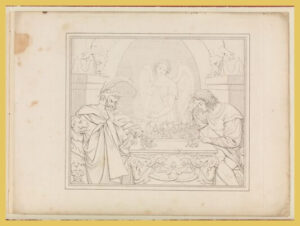 The painting checkmate is said to have been painted around 1831 year. Mainly due to some etchings that can now be seen online the met museum website – link
The painting checkmate is said to have been painted around 1831 year. Mainly due to some etchings that can now be seen online the met museum website – link
below is a list of known owners of checkmate painting with a date:
- Queen Isabella II of Spain (1830-1904).
- Monsieur Chappuis received the painting from Queen Isabella II of Spain as a gift.
- E. Constantin, Paris, acquired from the above in 1898, and thence by descent.
- Supposedly being hung in Louvre in between – but cannot really find any credible data confirming that.
- then in various hands until 1999 when it was sold at Christie’s Auction
Where is checkmate painting?
It’s a shame to say that the painting’s current whereabouts are unknown. Despite being sold at a Christie’s auction to private hands, it has disappeared from the public eye. As a chess lover, this is a disappointment, as I would love to see the painting in person and admire its beauty.
Checkmate Painting Louvre
Alright, let’s get to the bottom of this Checkmate painting legend, shall we?
So, apparently, there’s this rumor going around that at one point, the painting was hanging in the Louvre Museum.
Sounds pretty legit, right?
After some serious sleuthing, there’s just no credible data to support that claim. Which does not mean it wasn’t.
But wait, there’s more!
You might have also heard the story about how a chess master saw the painting and was so inspired that he studied it and learned how to win the game.
Well, turns out that part is actually true!
The Chessmaster in question was none other than Paul Morphy, and he did see the painting – or at least a reproduction of it – at Reverend Harrison’s house.
More on that later…
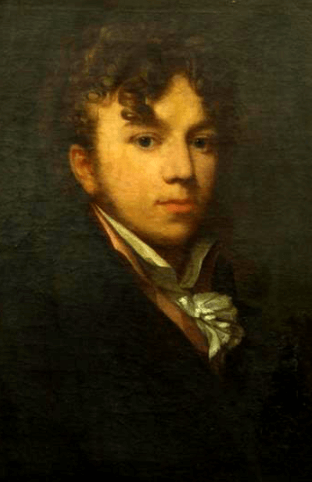 Moritz Retzsch painting checkmate
Moritz Retzsch painting checkmate
So, let’s talk about Retzsch in the context of his masterpiece painting, Checkmate.
This bad boy depicts a heated chess match in progress, and let me tell you, the drama and tension in this painting is off the charts.
The players’ faces are all over the place, ranging from super confident to downright anxious.
It’s like watching a tennis match, but way more intellectual.
Early Sketches of the painting titled checkmate
Interestingly, Retzsch did not create the painting all at once. Oh no, this was a months-long process of refining and perfecting.
He started with some sketches, and then just kept building and building until he had created a painting that would go down in history
Below few known sketches


Faust Checkmate Painting?
The painting itself is often referred to as Faust vs Mephistopheles playing chess. How come?
Retzsch was all about that Romantic era vibe, which was all about emotions, passion, and imagination.
He even went so far as to illustrate the tragic tale of Faust, and let’s just say he was pretty obsessed with that story. (26 plates at least)
Like, seriously obsessed.
What do Faust and Mephistopheles playing chess mean?
from what I gathered it all started from a Story from Eric Ritz which you can read below:
On display in the magnificent Louvre Museum in Paris, France, is that dramatic painting of Goethe’s Faust.
Faust is seated at a table engaged in a competitive game of chess. And at first glance, it looks like Faust is losing.
His opponent in the chess game is Satan. The devil sits there grinning smugly. He thinks he has the victory in hand.
He is pointing at the chessboard with an evil leer and he is gloating.
As you look at the painting, you can almost hear the devil shouting: “Checkmate! Game’s over! I win!”
However, a person with a keen eye who knows the game of chess can see that the match is not over at all.
The image of the two playing chess has become an enduring symbol of the struggle between good and evil, intellect and temptation, and the never-ending pursuit of knowledge.
It’s like watching a classic game of chess, but with a supernatural twist that adds a touch of excitement and drama to the mix.
Here’s a little nugget of knowledge about Mephistopheles – he’s technically not a devil, he’s a demon working for the big boss himself!
Sure, some folks might mix up his job description, but according to trusty ol’ Wikipedia, Mephistopheles is typically seen as a demon doing the Devil’s dirty work.
He’s usually just coming to collect the ones who are already doomed.
What is the story of playing chess with the devil?
Now, some people might argue that it’s Faust playing chess with Mephistopheles, but most stories I have seen talk about a devilish game between a young man and the devil himself.
The stakes are high, and the prize is none other than the poor dude’s soul!
It’s no wonder the checkmate painting has become a symbol of the eternal struggle between good and evil.
The painting has become a symbol of that epic battle, with the devil always lurking around, trying to snag another unsuspecting soul.
A great description of what happens on the board appeared in The Saturday Magazine, Volume 10. May 6, 1837, and goes as follows:
The peculiar powers of the artist have here a fine field for their exertion. The finely-formed, but wicked and terrific,
countenance of Satan is directed towards his victim, whom he is watching with wariness and stern purpose, that make us tremble f
with broad folds ; one hand is supporting his chin, as if he were intent on the effect of some deeply-plotted move,
or the beautiful and youthful antagonist. The fallen angel, who ” was a murderer from the beginning,” is robed in a mantle,
and the other grasps a figure of Peace, which he is taking from the board.
The young man rests his head upon his hand, as if he were fearful of impending ruin, and desirous of averting it.
Between these two figures, and behind the board, stands the Good Genius of Man, anxious and distressed, as if fearful for the youth.
Symbolism and meaning behind each element of the painting ‘Checkmate’
When it comes to setting the mood, Moritz really knew what he was doing!
The scenery is chosen with reference to the fearful thought to be expressed.
It is a wide vault/tomb, whose arch is formed by two lizard-shaped monsters, whose heads are half locust half bird
Chess board Symbolism in checkmate painting
The chessboard on top of a coffin shows this is a game of life and death. Then there are the dark caricatures of his chess pieces versus the peaceful, light pieces on the man’s side
They play it in the tomb, the upper surface of a tomb is chiseled into a chess board.
Satan symbolism
The arm of Satan’s chair is shaped as a hand on top of a skull.
His cap is the long and crooked feather from the cock’s tail, which, with the ancients, was the emblem of cunning and malice.
painting checkmate with the devil – figures
Interpretation of Black figures in Checmate Painting
- King – Satan
- Queen – Pleasure
- Castles – Anger, Indolence
- Bishops – Falshood, Pride
- Knights – Avarice and Envy, Unbelief
- Pawns – Doubts
Interpretation of White figures in Checmate Painting
- King – man’s soul
- Queen – Religion
- Castles – Hope, Truth
- Bishops – Peace, Humility
- Knights – Innocence, Love
- Pawns – Angels
With regard to the Chessmen: on the side of the demon, the King represents himself; his Queen is Pleasure, pressing forward in front of all; his officers are, Indolence, like a great swine ; Pride, strutting about with a peacock’s tail; Falsehood, with one hand on his heart, and the other
holding a dagger behind him; Unbelief, trampling on the Cross; Anger, &c.; the Pawns are Doubts ; and, alas for devoted man! the only pieces which he has taken are Anger, like a turkey-cock, and one Doubt; while Satan has secured several cherub forms, which are the Pawns of Man, and are symbolical of Prayer.
There is no little beauty in the thought of introducing prayers under the emblem of pawns; inasmuch, as, if persevering and effectual, they may recover the vantage-ground which had been lost. Humility, Affection, and Innocence, are also taken ; but Religion, Truth, and Hope are still left. All the pieces are well set forth ; and it is evident that Satan’s arc coming down in full force against thoseof his antagonist.
The Saturday Magazine, Volume 10. May 6, 1837
And now for the game itself. On Satan’s side, the King is his own image, muffled, indeed, in a cloak, but still known at once. His Queen, a voluptuous female, with uncovered bosom, is Pleasure; her left hand pointing to her own seductive charms, while her right holds out the intoxicating cup. The six officers of Satan are six vices. The first is Indolence; with heavy form, and hanging arms, and stupid look, sitting idly on an unhewn block of wood. The second is Anger; rash and headlong, like the turkey-cock, that flies into a rage with every object, and having the head of that easily excited bird. The third is Pride, moving stiffly forward, with a feather crown, and bead tossed backward, a» if in scorn; with spurs on the heels, and an order on the breast; a full purse in one hand, and the other stretched haughtily forth, as if giving a command. He seems looking back at his splendid peacock’s tail, which, as it is spread for display, hides from his own eyes the uncomely parts which it exposes to the view of others. The fourth is Falsehood; spotted like a tiger, and with a head like a cat; one hand on the breast, as if to assure good faith, while the other conceals a dagger behind her back. The fifth is Avarice, with Envy, as one person, bent and lean, gnawing its own hand, and pressing a casket, under its arras. The sixth and last, is Unbelief, a bold and impudent figure, horned, and with hands to its sides, as if in token of self-sufficiency, and overthrowing a cross with its foot. The eight pawns are Doubts; small, harpy shaped creatures, with wings like bats, emblematic of darkness, and sharp teeth, ready to bite and devour.
On the side of the young man, his own soul is the King, with a broad robe firmly drawn about him, and the wings of the butterfly on his shoulders, in token of his immortality. His Queen is Religion, the most powerful of all defenders ; a noble, majestic female, with angel wings; one hand outstretched, as though giving protection, and the other holding the cross, the emblem of the faith. The first, of his officers is Hope, resting on her anchor, and looking forward as though in expectation. The second is Truth, with a lighted torch and a reflecting shield, standing with Hope, as a castle, on her side. The third is Peace, with the palm branch in her hand The fourth is Humility, with her head bent in prayer, and her person plainly clad. The fifth is Innocence, as a naked child, unsuspecting and guileless, and stretching forth its arms confidingly to all. And sixth, and last, is Love—two children affectionately embracing each other, with cheek pressed to cheek, while above them is a bright single star. The pawns are Angel Heads, winged and worshipping, signifying prayers; for, as in the game of chess, an officer lost may be recovered by a pawn, so a spiritual loss may often he recovered by prayer.
Our Monthly 1872 OUR MISCELLANY. THE GAME OF LIFE. -Byron Edwards, D.D.
1st. Indolence (Castle), sitting on an unhewn block of wood, with the head of a swine; 2d Anger (Castle), like a turkey cock; 3d Pride (Bishop), grave, moving stiffly forward, wearing on his head— which is tossed backwards — a feather crown, one arm insolently Ihrust into his side, but forgetful while displaying his splendid peacock’s tail how much of what disgraces him he leaves behind him—one hand holds a full purse, the other is stretched out as if giving command; 4th Falsehood (Bishop), a form spotted like a tiger’s, with the head of a cat, the ears laid fawningly back, one hand is placed upon the breast, and the other hides a dagger behind her; 5th Avarice and Envy in one form, a bent lean figure gnawing its own hand and pressing a casket under its arm; 6th Unbelief, an impudent horned figure, both hands thrust into its sides and overthrowing the cross with its foot. The eight Pawns are Doubts—small, harpy-shaped creatures, with wings like bats and sharp teeth.
Man’s King is his soul, with wings of a butterfly on his shoulders. His Queen is Religion, a lofty, majestic figure, with ample pinions, stretching out one hand as giving protection, and holding in the other the sign of expiation.
The officers are—1st Hope (Castle), with her anchor; 2d Truth (Castle), with a lighted torch and a reflecting shield, stands with Hope as a castle at her side; 3d Peace (Bishop), with the palm; 4th Humility (Bishop), her head bent in prayer and her person sparingly clad; 5th Innocence (Knight), a naked child stretching forth its arms confidently to all; 6th Love (Kt), two children embracing each other, while above both rests a single star. The Pawns are here represented as angels’ heads, winged and worshipping.
-Miron “The Larches, ” Nov., ’88.
checkmate painting story in modern-day sermons
The story involving checkmate painting has been told by Christian speakers as far back as 1955 when Billy Graham told a variation of it early in his ministry.
They love to use the symbolism of that famous painting, along with the story of the chess master, to illustrate the eternal struggle between good and evil in countless sermons over the past couple hundred years.
What a Friend we have in Jesus
Painting of Check Mate – is it really? the story of one more move
So get this – the painting is called “Checkmate” (which, by the way, isn’t even the painting’s original name), and the real fame and recognition of this piece seem to have come from a story about a chess master’s observation.
He stared at the painting for a while and was like, “Hold up, hold up, this isn’t checkmate yet! The king’s got one more move!”
Even though it looks like the devil has won the match for the man’s soul, it turned out there’s still hope. There’s still a chance for the man to come out on top.
And let me tell you, that message has caught on like wildfire!
The story has now been used in religious sermons all over the world as a message of inspiration ‘no matter how bad things seem there is always a way out, a solution or another move’
there are several versions of how the one more move story is told, see below for a few examples:
- Once housed within the Louvre art museum, a masterpiece known as “Checkmate” by Friedrich Moritz August Retzsch has now found its place in the hands of a private collector. This painting features two chess players; one is the infamous Satan, who exudes confidence and arrogance, and the other player is a despondent-looking man. As per the painting, if Satan emerges victorious, he gains ownership of the man’s soul.
Legend has it that a chess grandmaster once visited the museum and upon observing the painting, noticed that the chess pieces’ arrangement was incorrect. According to him, despite Satan’s apparent confidence, he was not winning. On the contrary, the man who appeared to be losing was in fact winning the game. The grandmaster deduced that based on the pieces left on the chessboard, the man’s king had one more move left, which would result in his victory. - There was a painting that was once displayed at The Louvre Museum in Paris. The painting was later acquired by a private collector, and it was during this time that Paul Morphy, a master chess champion, came across it. There are different versions of the story, but one popular variation is that Morphy studied the painting and commented, “It ain’t over.” Morphy then asked the painting’s owner to set up a chessboard that was identical to the one depicted in the painting. Within a few moves, Morphy was able to win the game. This story highlights Morphy’s impressive chess skills and his ability to quickly assess a game, even when it appeared to be in its endgame.
- The well-known tale goes that a skilled chess player, often unnamed, came across a reproduction of Moritz Retzsch’s painting “Checkmate” (originally titled “Die Schachspieler” or “The Chess Players”) while visiting a museum. Upon examining the chessboard depicted in the painting, the player realized that the position of the young man in the painting was not as hopeless as it might appear at first glance. The story is still told today as an example of how careful analysis and strategic thinking can lead to unexpected opportunities, even in the face of apparent defeat.
- Two men are standing in front of a painting in an art gallery. The painting depicts a man playing chess with the devil, and the devil appears to have won as he has the man cornered with a grin on his face. The title of the painting, “Checkmate,” indicates that the game is over and the devil has emerged victorious. The first man wants to move on to view other paintings in the gallery, but the second man, who happens to be an international chess champion, wants to study the painting further. He asks his friend to go ahead without him and promises to catch up later. As the chess champion stares at the painting, he suddenly steps back in amazement and exclaims, “It’s wrong! There’s one more move!” He rushes back to his friend and asks him to take a closer look at the painting. The chess champion insists that the painting is not accurate because the King has one more move. The two men decide that they need to contact the painter and inform him of the mistake. They believe that the painting should be corrected to reflect the true outcome of the chess game.
- The painting depicts a game of chess being played for the young man’s soul, with the devil sitting on one side and the young man on the other. The young man appears to be in despair because the devil has made a move that has trapped his king, and it seems that he has lost the game and his soul. However, when a famous American chess master named Paul Morphy saw a reproduction of the painting, he became excited and shouted at the young man not to give up, as he could still win the game by moving his king to a certain square.It is interesting to note that people who are familiar with chess have analyzed the arrangement of pieces in the painting and concluded that the young man’s situation is impossible, as he has already lost the game. However, Morphy’s knowledge and experience as a chess master allowed him to see a move that others had overlooked, giving the young man a chance to win the game and save his soul.This story highlights the importance of not giving up, even in seemingly hopeless situations. Sometimes, it takes a fresh perspective or an outside observer to see a way out of a difficult situation. It also emphasizes the value of knowledge and experience in recognizing opportunities that may not be immediately apparent to others.
Is the Checkmate painting story true?
out of all these stories, the most popular one is about the painting hanging in a museum/louvre and a chess master looking at it.
All have got a part of truth in them.
THE story that comes closest to the truth is the last one, about a real-life chess genius named Paul Morphy who saw a replica of the painting in a friend’s house.
Who was Paul Morphy?
He was this super cool American dude who lived way back in the 19th century and was a total boss at chess.
Morphy was known for his mad tactical skills and intuitive playing style, which basically helped him crush his opponents left and right.
He was like a chess ninja!
In fact, he’s considered a pioneer of modern chess strategy – pretty impressive for a guy who lived so long ago, right?
10 fun facts about Paul Morphy
- Morphy was born in New Orleans in 1837, and learned how to play chess at the age of 10 from his family members.
- He was a prodigy, and by the time he was 17, he was considered one of the best chess players in the world.
- In 1857, Morphy traveled to Europe and dominated every opponent he faced, including the top chess players of the time.
- Morphy was known for his aggressive and attacking style of play, which was unusual for his time.
- Despite his success, Morphy retired from competitive chess at the young age of 21.
- After retiring from chess, Morphy went on to study law, but he never practiced as a lawyer.
- Morphy was a lifelong bachelor and never married.
- He was a talented musician and spoke several languages fluently.
- Morphy suffered from mental health issues in his later years, and there are conflicting accounts of his cause of death.
- Despite his short career, Morphy’s legacy as one of the greatest chess players of all time has endured, and he is still celebrated by chess enthusiasts around the world.
Devil Playing Chess Painting – Controversy around Paul Morphy story
Well, it turns out that the first mention of the One more move story was way back in 1888 in the Columbia Chess Chronicle.
The story was part of an article titled “Anecdote of Morphy” and appeared on page 60 of Volume III, Number 7, 8.
And if you want to read the whole thing, including the original text, it’s all right there in black and white.
THE following anecdote of that phenomenon of Chess, Paul Morphy, may interest not only the lovers and followers of the game, but the general public as well. It was related to the writer by the gentleman at whose home in Richmond, Va., the incidents occurred.
The host of that evening, twenty odd years ago, survives the champion, and still, with undiminished vigor and ever fresh enthusiasm, gladly gives combat as of old to any Knight who essays his prowess on the checkered field ; and it may be premised, whether he prove victor or defeated, that any such essayist will enjoy a combat which may readily be arranged for at the ‘Chess Club at Richmond, Va.
In the early days of ” the late unpleasantness” when it would have been much more difficult to have arranged for a casual Chess encounter between North and South “that has been premised above, the celebrated Paul Morphy happened to be in Richmond, as an officer on Beauregard’s staff.
The war spirit must have been very absorbing in most men’s minds, and of deepest import was it to our friends. Still it takes a great deal to thoroughly banish Chess. The arrival of the noted player excited, even at that troublous time, a keen interest among the lovers of the kingly game. An invitation was extended to the champion, and, with himself as the centre, a coterie of notables assembled for an evening’s play at the home of the hospitable Mr. H.
How fortune went with Mr. Morphy in the earlier part of the evening mat easily be inferred.
While at supper Morphy’s attention was attracted by a picture which hung prominently upon the wall. This picture seems to be pretty well known, , and indeed somewhat celebrated, although the writer regrets that he himself never had the pleasure of meeting with it. It represents the—to speak politely – and he is thus politely depicted – Mephistphiles [sic] playing a game of Chess with a young man for his soul. The Chessmen with which his Satanic Majesty plays are the Vices ; the pieces of the young man are, or have been, the Virtues—for, alas! he has very few left. In bad case, indeed, is the unhappy youth, for his game, as represented, appears not only desperate but hopeless, and his fate sealed. His adversary gloats in anticipation of the final coup. and the gleaming smile on the face of the hitter intensifies the despair which that of the young man shows.’ With the close of the supper, deeply interested, Morphy approached the picture, studied it awhile intently, then turning to his host he said, modestly: “I think that I can take the young man’s game and win.” ” Why, impossible !” was the answer; “not even you, Mr. Morphy, can retrieve that game.” ” Yet, I think I can.” said Morphy. ” Suppose we place the men and try.” A board was arranged, and the rest of the company gathered round it, deeply interested in the result. To the surprise of every one, victory was snatched from the devil and the young man saved.
Thinking that a blunder must have led to this unexpected result, one after another did each sober, serious gentleman essay the devil’s part, and to each in turn did Mr. Morphy prove that not even on intellectual grounds could the “enemy” be defended, for Morphy beat them one and all. The writer, who sends the narrative, thinking it too good to be lost, has long been interested to see this picture ; and it may interest readers to look for it, and with the position which is represented, try whether he or she could make an escape from the claws of the Evil One.
G. R. F.
And speaking of good stories, Retzsch’s “The Chess Players” painting and engravings were all the rage back in Paul Morphy’s day.
It’s no wonder that the “one more move” tale caught on like wildfire in the newspaper.
In fact, they even got several responses trying to undermine the story – by contradicting some of the facts as well as attempting to recreate the chessboard layout – most of which you can read about here.
eventually, after all the back-and-forth, the Reverend R.R. Harrison (a big-shot lawyer in Richmond back in the day – at whose house the whole story actually happened) decided to ditch the whole anonymous act and set the record straight.
He dropped a massive two-page letter to the Chronicle, backing up original Frith’s anecdote about Morphy with some serious facts.
He even corrected some of the dates and put to rest Galbreath’s initial objection that Morphy wasn’t really serving on General Beauregard’s staff in the Confederate army.
below is the excerpt of his letter from the chronicle
Checkmate painting position
That letter from Reverend R.R. Harrison has made it clear that the Morphy story is totally legit.
But, I still have one burning question: what’s the deal with that chess position in the painting?
How would it even work in a game against the devil?
The most popular theory comes from Gilbert, who did his best to give some credibility to the story.
I have put it into lichess engine to see how likely it is to win.
Seems like in most cases Morphy must have been better than stockfish to find out the moves.
A lot will also depend on the agreement as to what figure each vice represents.
let’s start with the position that is from chess chronicle, one that Gilbert has proposed
Gilbert’s Position of Checkmate Painting
Link to analyze the position on Lichess
this one shows mate in 6 even if white starts.
It also doesn’t make sense because in the painting the black King clearly is on black squares. ( if you turn it around it would then make more sense)
Kenilworthian Position of Checkmate Painting
now there is a version on the Kenilworthian blog that seems to be the one that is closest to something that could actually be drawn
Link to analyze the position on Lichess
Kenilworthian Position + pawn of Checkmate Painting
If we would have added one pawn to this equation though, the scenario would look slightly different, showing +1 on stockfish. Still likely a draw
The main thing we need to bear in mind – is unlikely folks who played against Morphy in the 19th century would move with the same accuracy as stocfkish 🙂
Chesslovin Position of Checkmate Painting
bearing in mind Miron “The Larches, ” Nov., ’88. description of chess pieces –
none of the above positions would sort of make total sense.
Kenilworthian is technically closest to truth but does not include pawns and all of the figures, especially if they were identified as per below.
1st. Indolence (Castle), sitting on an unhewn block of wood, with the head of a swine; 2d Anger (Castle), like a turkey cock; 3d Pride (Bishop), grave, moving stiffly forward, wearing on his head— which is tossed backwards — a feather crown, one arm insolently Ihrust into his side, but forgetful while displaying his splendid peacock’s tail how much of what disgraces him he leaves behind him—one hand holds a full purse, the other is stretched out as if giving command; 4th Falsehood (Bishop), a form spotted like a tiger’s, with the head of a cat, the ears laid fawningly back, one hand is placed upon the breast, and the other hides a dagger behind her; 5th Avarice and Envy in one form, a bent lean figure gnawing its own hand and pressing a casket under its arm; 6th Unbelief, an impudent horned figure, both hands thrust into its sides and overthrowing the cross with its foot. The eight Pawns are Doubts—small, harpy-shaped creatures, with wings like bats and sharp teeth.
Man’s King is his soul, with wings of a butterfly on his shoulders. His Queen is Religion, a lofty, majestic figure, with ample pinions, stretching out one hand as giving protection, and holding in the other the sign of expiation.
The officers are—1st Hope (Castle), with her anchor; 2d Truth (Castle), with a lighted torch and a reflecting shield, stands with Hope as a castle at her side; 3d Peace (Bishop), with the palm; 4th Humility (Bishop), her head bent in prayer and her person sparingly clad; 5th Innocence (Knight), a naked child stretching forth its arms confidently to all; 6th Love (Kt), two children embracing each other, while above both rests a single star. The Pawns are here represented as angels’ heads, winged and worshipping.
here’s my deciphering of the position with the above in mind
( although one white pawn may be on a different square, and one black pawn I assume must have been taken down entirely and hidden behind a black bishop.)
See below for an original checkmate painting with chess figures overlay.
here’s a link to the game, stockfish says 7 moves only to be mated.
again – if you play the position with lower-rated players, it is possible to win it.
Alternative Etsy Checkmate Painting Position
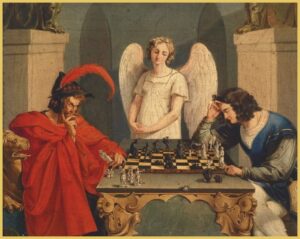 If you go to Etsy – you can find a lot of listings of a picture called Faust and Mephistopheles playing chess.
If you go to Etsy – you can find a lot of listings of a picture called Faust and Mephistopheles playing chess.
That looks slightly different from the original picture up there, doesn’t it? 2 white pawns are to the right of white’s queen.
Still a losing position, but bit better than most
link to the analysis on Lichess
So i guess now we’ve got a big question on our hands – which version of the checkmate painting did Morphy actually lay his eyes on?
which brings us to another point:
Other versions of checkmate paintings
Moritz Retzsch isn’t the only artist to have a painting named ‘checkmate’!
That’s right, there are actually both different versions of this masterpiece and other paintings by different authors that are named ‘checkmate’.
Well, well, well, it turns out that Moritz Retzsch’s painting “checkmate” isn’t the only one out there with that name. I mean, let’s be real here, “checkmate” is like the most commonly used term in every game of chess ever played. So, it’s really not all that surprising that there are other paintings with the same name.
Who knew that such a simple title could have so many different interpretations?
The chess players (checkmate) in Glynn Vivian Art Gallery
Watercolour Painting of Checkmate scene at kimcuriosityshop
Checkmate, 1929, Art Painting by William Roberts
Painting titled ‘Checkmate’ by Bernard-Louis Borione
Painting titled ‘Checkmate’ by Laure Bollinger
Painting titled ‘Checkmate’ by Bill Stephens
Bronze Bas relief of Checkmate Painting.
In the mid-19th century, Anthony W. Jones was crushing it as a sculptor and created amazing work of art based on the checkmate painting- a bronze bas-relief sculpture of a young dude playing chess with the devil, battling for his soul while a sad but stunning angel watches over.
Fast forward to now, and thanks to modern mold materials and technology, the family has managed to be able to replicate this chess masterpiece!
And the best part?
You can now own a piece of this masterpiece for yourself!
Thanks to modern mold materials and resin technology, the family of Anthony W. Jones has made it possible to accurately duplicate all the intricate details of this bas relief chess art.
You won’t miss a single line inscribed on the angel’s wings. You can get it here
Checkmate Painting FAQ
Checkmate Painting
Yes, technically the Checkmate painting is really checkmate and accurate. However, according to the anecdote, a chess master named Paul Morphy claimed there was a move that could win the game. He played with other players to prove his point, but no one has been able to reproduce the same move fully.
In Goethe’s Faust, Faust and Mephistopheles playing chess symbolizes the struggle between good and evil for the human soul. The game represents the ongoing battle between Faust’s desire for knowledge and Mephistopheles’ temptation to lead him astray. The outcome of the game reflects the eternal question of whether good or evil will ultimately prevail.
When it’s said that the king has one more move, it means there is still a chance to win or at least to continue playing. It means that the game is not yet over. In chess, if a player puts their opponent’s king in checkmate, the game ends immediately. But if the opponent’s king has one more legal move, the game continues.
The original Checkmate painting portrays Faust, a young man, in a game of chess with the devil, where he’s on the verge of being checkmated. The painting symbolizes Faust’s battle for his soul, where he’s unable to escape being checkmated despite his efforts. Checkmate painting is a representation of the eternal struggle between good and evil.
The painting “Checkmate” by Moritz Retzsch depicts a devil playing a game with a man over his soul. The figures in the painting represent various vices, symbolizing the struggle between good and evil.
The story of “One More Move” painting tells about perseverance and hope in the face of challenge. Inspired by Moritz Retzsch’s “Checkmate” painting and the legendary chess player Paul Morphy, it reminds us to never give up and to always look for one more move towards victory.
The story of playing chess with the devil, also known as the “Faustian chess” is about person who challenges the devil to a game of chess, with the stakes being their soul. The devil accepts and the game begins. The person ultimately wins, outsmarting the devil and saving their soul. The tale is often used as a cautionary tale about the dangers of greed and temptation.
The original name of the Checkmate painting by Moritz Retzsch’s was ‘die Schachspieler’. This painting is a famous representation of a chess game and is well-known for its intricate details and strategic composition. ‘Die Schachspieler’ translates to ‘The Chess Players’ in English and is a testament to Retzsch’s artistic prowess.
“Checkmate” by Moritz Retzsch was painted in 1831. Most likely comissioned by Queen Isabella II of Spain. The painting depicts a chess game where the player is seemingly trapped and cannot make any moves. It is often refered to as “One More Move” suggests that the losing side could have prevented their defeat with just one more move.
Moritz Retzsch, a German painter, has painted the ‘Checkmate’ painting. The painting is known for its intricate depiction of a chess game with an impending checkmate. Retzsch’s attention to detail and skillful use of shading and perspective have made this painting a celebrated work of art.
The painting “Checkmate” was not written by anyone as it is a painting, not a written work. The painting was created by a German painter named Moritz Retzsch. It is said to be loosely based on a play about Faust written by Goethe.
The painting is called Checkmate because it depicts a young man named Faust who is on the verge of being checkmated by the devil in a game of chess. The painting symbolizes the battle for Faust’s soul and how he is seemingly unable to avoid being checkmated despite his efforts.

